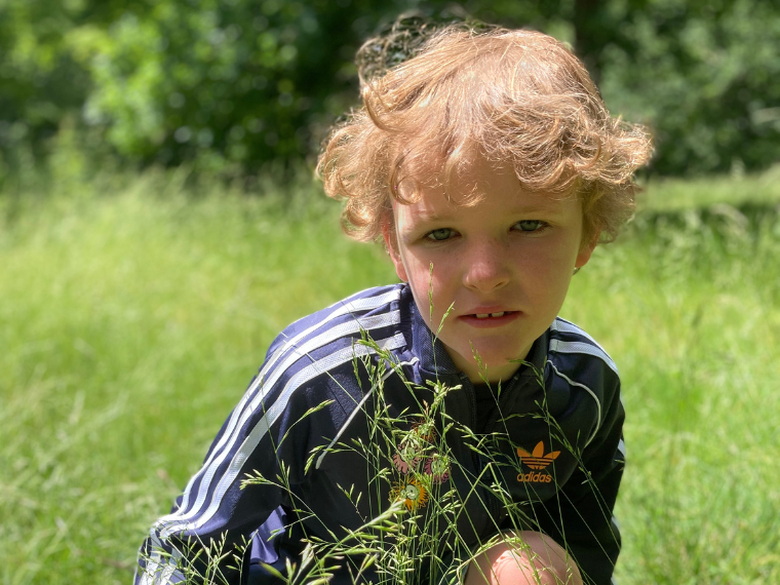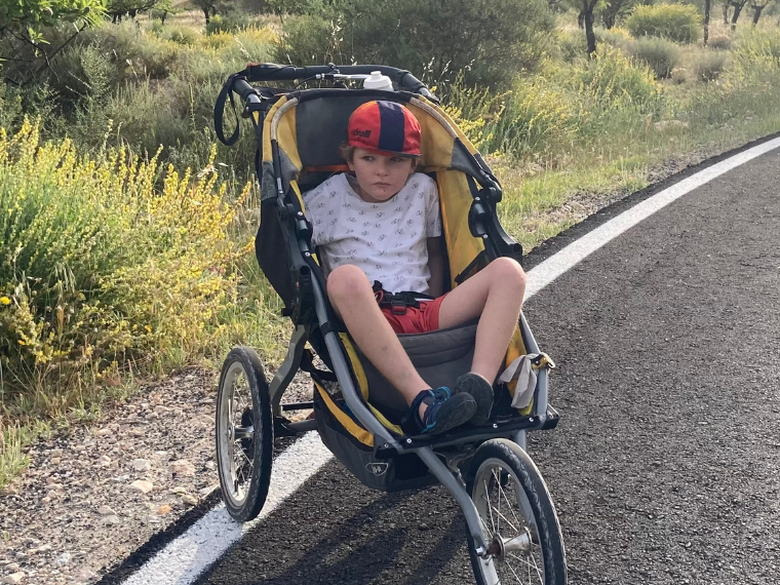4 images
Finn
Finn lives with his parents, Helen and Marcus, in London. He had his first seizure at 16 weeks old. Mum, Helen, shares their story.
Finn was born in August 2015 by emergency caesarean section. He had his vaccines one morning in December, when he was 16 weeks old and that night, at around midnight, I heard him rustling in his crib next to me. When I checked him, I knew straight away that something really was not right – his movements weren’t right, he was jerking and his face didn’t look right; it was twitching. Terrified, I called an ambulance for the first time in my life.
Luckily, living in central London, the ambulance arrived in less than 10 minutes and we were taken to the Royal Free Hospital. The paramedics told me that it was likely a febrile seizure. Finn had been seizing for around 20 minutes by then and they gave him Diazepam. We were immediately taken to resus where a big team worked on him, followed by admittance to the ward, where over the next few days Finn had several checks, including a lumbar puncture. The tests all came back clear and we were discharged with Midazolam as a precaution in case it happened again.
A junior doctor called me the following day to advise us that we needed to always keep the Midazolam with Finn and asked us to attend the Epilepsy Clinic at the hospital at the end of the week. I guess it was dawning on me that this might not be a ‘one-off’.
At the Epilepsy Clinic, the specialist paediatrician – who is amazing - talked me through various things: the different epilepsies, our family histories not including epilepsy and the unusual long duration of Finn’s seizure. She also discussed SUDEP (Sudden Unexpected Death in Epilepsy) and warned us to be vigilant and aware of seizures coming again. I’m generally a positive person and don’t dwell on things usually, but I was alarmed to be told about SUDEP – it was frightening - I’d no experience of epilepsy before Finn’s seizure.
We carried on as normal until January. I’d nipped to the shop and Marcus called me to say that something was wrong. Finn’s face was twitching and he was jerking on one side of his body. We called an ambulance and were immediately taken to hospital again. The seizure lasted longer than 15 minutes.
Diagnosis
In the days and weeks that followed Finn had an MRI at The Royal Free and was referred to the neurology team at Great Ormond Street (GOSH) where he had a 12-hour EEG. His tests came back normal - there appeared to be no abnormalities. However, he continued to have regular status seizures of varying types, frequently tonic clonics with regular hospital stays. We agreed to blood tests being sent off for genetic testing to see if that could bring answers.

Finn’s first sedation and transfer to a PICU, where he was put on a ventilator, was at 6 months old. In the first 14 months of his life, he had 4 very similar stays in PICU and I’d called ambulances more than 100 times for prolonged seizures. We were constantly back and forth to the hospital – we would be discharged in the morning only to be readmitted that afternoon.
In the run up to receiving the genetic test results and in the way that Finn was presenting seizure wise, we sensed a strong suggestion from the medical teams that it could be Dravet Syndrome. Finn was diagnosed with Dravet Syndrome (SCN1A mutation) at 7 months old.
Following the diagnosis, Finn was able to be put on more specific Dravet Syndrome medication; Sodium Valproate, Stiripentol and Clobazam. We felt it was the best we could do, but unfortunately, the prolonged seizures and hospital admissions continued. It was around this time when the neurologists at GOSH suggested Finn be referred onto the Fenfluramine trial and we realised we didn’t have many other options. As scary as it was, we knew we needed to try something else, as nothing was working for him - so we went for it.
Next steps
The first 6 weeks of the trial meant a drug hold and monitoring seizure activity to establish a baseline. Following this, Finn was admitted to the double-blind trial that was supposed to be a 12-week period. Thinking back, it was a horrific time. We didn’t know if Finn was on the trial drug or not and all his other meds were held at pre-study levels. The situation did get really bad - he was in hospital constantly, each time following the emergency protocol, with emergency medications needed. We were about to give up and come off the trial, which we discussed with the study team, who compassionately agreed to let Finn out of the double-blind trial slightly early and moved him onto the open label study.
We started to see an improvement a couple of months into having Fenfluramine. He still had tonic clonics but they became less ‘impactful’. They were slightly shorter and we didn’t need to administer rescue medication as quickly. They also let us increase Finn’s other medications, which helped too.
Challenges
We had an Education, Health and Care Plan (EHCP) in place by the time Finn was 2 years old. Despite the positives of this, it meant that Finn’s nursery had to ‘let him go’ as they couldn’t provide the 1:1 care the EHCP asked for. It was a stressful time and Finn was out of nursery for a month and a half while Marcus and I battled with the council, sought legal advice and talked to advisory groups to find a new nursery for him with the right support.
Eventually, he moved to a nursery where he could get the 1-2-1 support and care the EHCP stated. It was close to my work, so if he had a seizure, I’d be able to run there fast and arrive, usually, at the same time as the first responder. The staff there were incredible, and it was the first time we felt ‘held’ – they were really willing to help Finn, and us, to cope.
We have family all over the world and Dravet Syndrome means that we haven’t been able to travel as we’d like to. Only until very recently we stayed within the UK and Ireland. Whenever we looked to go anywhere, we would research the local hospitals, how long it would take for an ambulance to arrive and get Finn into the emergency department. Our family have had to come to visit and help us, and sometimes when we were at our lowest, which is the most beautiful thing. We have only recently been to Spain to see Finn’s grandparents; however, we are still quite restricted, which is a real shame for Finn.
Support from DSUK
We joined Dravet Syndrome UK when Finn was around a year old. I struggled to accept the support of the community at first. I needed to grieve and learn to accept his diagnosis, before becoming active and joining in. I now really appreciate the knowledge shared on the online forum and we’ve attended all of the conferences since Finn’s diagnosis. The conferences hold nothing back, but it was something we needed to face up to in order to equip ourselves on our journey. It’s amazing to have the medical professionals, the researchers, the global experts there, to explain the facts and the hope in developing research. There were also the breakout sessions at the most recent conference, with legal advisors and practical support – very useful. Touching base and speaking with other families who understand, really helps us too.
The most fabulous lively, happy & loved boy
Finn, now aged 7, still has seizures, mostly nocturnal seizures and he suffers badly from cluster seizures. The cluster seizures are so hard and they break my heart. He can have around 20 or so 1-minute tonic clonics one night, followed by a similar number the next. It’s exhausting for him and he doesn’t eat for a few days after. Then he may have a few good days and then another round of cluster seizures. It’s so unfair when the bad days outnumber the good. On a positive note, we are currently on a 100-day break, which is the longest it’s ever been. This break is an amazing boost for us as a family, as it has allowed him to pick up some new words at school and for us to have some rest too.
Finn attends the local special needs school where he loves swimming, the trampoline and the music class – he loves sensory. He is an extremely lively and active boy, with an ADHD diagnosis, who is getting stronger, which is fabulous, but can also be tiring and challenging. He loves being out and about and running around and is such a happy boy, with no malice whatsoever. He is ‘Finn the fearless’ in that he has very limited danger awareness. Partly due to this, his autism diagnosis and other behavioural traits, we have a ‘chariot’ to get him out and about in London. We often take him to Parkrun in this large running buggy and he is absolutely thrilled when we run down the Hampstead Heath hills.
Finn loves sensory books, which is useful in that he might sit for a few minutes; ‘The Very Hungry Caterpillar’ is his favourite, of which we’ve had very many copies. Unfortunately, he doesn’t watch any television, but he is captivated by Justin Timberlake’s ‘Can’t stop the feeling’ music video – 4 minutes 46 seconds on YouTube! Finn loves people; he doesn’t have loads of words but is very good at shouting ‘HELLO!’ to perfect strangers on the street and he gives the best bear hugs!

